Myricetin Amplifies Glucose–Stimulated Insulin Secretion via the cAMP-PKA-Epac-2 Signaling Cascade
Abstract
1. Introduction
2. Methodology
2.1. Materials
2.2. Animals
2.3. Pancreatic Islet Isolation from Mice
2.4. Glucose-Stimulated Insulin Secretion Assay
2.5. Identification of Optimal Dose
2.6. Identification of Mechanism of Action
2.7. In Silico Analysis
2.8. Statistical Analysis
3. Results
3.1. Effect of Myricetin on Insulin Secretion from Isolated Mice Islets
3.2. Myricetin Effect Is Glucose-Dependent, Independent of the KATP Channel
3.3. Ca2+-Dependent Insulin Secretory Effect of Myricetin
3.4. Myricetin Role in Inhibition of cAMP Hydrolysis and/or Activation of cAMP Production
3.5. PKA Mediated Myricetin-Induced Insulin Secretion
3.6. Epac 2 Mediated Insulin Release by Myricetin
3.7. In Silico Validation of Targets Occupied by Myricetin
3.8. MEK Kinase-Mediated Myricetin-Induced Insulin Secretion
4. Discussion
5. Conclusion
Author Contributions
Funding
Institutional Review Board Statement
Informed Consent Statement
Data Availability Statement
Conflicts of Interest
Correction Statement
References
- Xourafa, G.; Korbmacher, M.; Roden, M.J. Inter-organ crosstalk during development and progression of type 2 diabetes mellitus. Nat. Rev. Endocrinol. 2024, 20, 27–49. [Google Scholar] [CrossRef] [PubMed]
- Bouchi, R.; Kondo, T.; Ohta, Y.; Goto, A.; Tanaka, D.; Satoh, H.; Yabe, D.; Nishimura, R.; Harada, N.; Kamiya, H.; et al. A consensus statement from the Japan Diabetes Society: A proposed algorithm for pharmacotherapy in people with type 2 diabetes. J. Diabetes Investig. 2023, 14, 151–164. [Google Scholar] [CrossRef] [PubMed]
- Mohajan, D.; Mohajan, H.K. Oral Hypoglycaemic Agents: Non-Insulin Medications for Type 2 Diabetes Patients. Innov. Sci. Technol. 2024, 3, 23–31. [Google Scholar] [CrossRef]
- Kalwat, M.A.; Scheuner, D.; Rodrigues-dos-Santos, K.; Eizirik, D.L.; Cobb, M.H. The pancreatic ß-cell response to secretory demands and adaption to stress. Endocrinology 2021, 162, bqab173. [Google Scholar] [CrossRef] [PubMed]
- Campbell, J.E.; Newgard, C.B. Mechanisms controlling pancreatic islet cell function in insulin secretion. Nat. Rev. Mol. Cell Biol. 2021, 22, 142–158. [Google Scholar] [CrossRef]
- Hameed, A.; Hafizur, R.M.; Khan, M.I.; Jawed, A.; Wang, H.; Zhao, M.; Matsunaga, K.; Izumi, T.; Siddiqui, S.; Khan, F.; et al. Coixol amplifies glucose-stimulated insulin secretion via cAMP mediated signaling pathway. Eur. J. Pharmacol. 2019, 858, 172514. [Google Scholar] [CrossRef]
- Hameed, A.; Hafizur, R.M.; Hussain, N.; Raza, S.A.; Rehman, M.; Ashraf, S.; Ul-Haq, Z.; Khan, F.; Abbas, G.; Choudhary, M.I. Eriodictyol stimulates insulin secretion through cAMP/PKA signaling pathway in mice islets. Eur. J. Pharmacol. 2018, 820, 245–255. [Google Scholar] [CrossRef]
- Abd El-kader, A.M.; El-Readi, M.Z.; Ahmed, A.S.; Nafady, A.M.; Wink, M.; Ibraheim, Z.Z. Polyphenols from aerial parts of Polygonum bellardii and their biological activities. Pharm. Biol. 2013, 51, 1026–1034. [Google Scholar] [CrossRef]
- Borck, P.C.; Vettorazzi, J.F.; Branco, R.C.; Batista, T.M.; Santos-Silva, J.C.; Nakanishi, V.Y.; Boschero, A.C.; Ribeiro, R.A.; Carneiro, E.M. Taurine supplementation induces long-term beneficial effects on glucose homeostasis in ob/ob mice. Amino Acids 2018, 50, 765–774. [Google Scholar] [CrossRef]
- Benziane, M.N.A.; Acem, K.; Aggad, H.; Abdali, M. Phytochemistry, HPLC profile and antioxidant activity of aqueous extracts of Fenugreek (L.) seeds grown in arid zones of Algeria. Acta Sci. Nat. 2019, 6, 71–87. [Google Scholar]
- Imran, M.; Saeed, F.; Hussain, G.; Imran, A.; Mehmood, Z.; Gondal, T.A.; El-Ghorab, A.; Ahmad, I.; Pezzani, R.; Arshad, M.U.; et al. Myricetin: A comprehensive review on its biological potentials. Food Sci. Nutr. 2021, 9, 5854–5868. [Google Scholar] [CrossRef] [PubMed]
- Sok Yen, F.; Shu Qin, C.; Tan Shi Xuan, S.; Jia Ying, P.; Yi Le, H.; Darmarajan, T.; Gunasekaran, B.; Salvamani, S. Hypoglycemic effects of plant flavonoids: A review. Evidence-Based Complementary and Alternative Medicine. Evid. Based Complement. Altern. Med. 2021, 2021, 2057333. [Google Scholar] [CrossRef]
- Li, Y.; Zheng, X.; Yi, X.; Liu, C.; Kong, D.; Zhang, J.; Gong, M. Myricetin: A potent approach for the treatment of type 2 diabetes as a natural class B GPCR agonist. FASEB J. 2017, 31, 2603. [Google Scholar] [CrossRef]
- Karunakaran, U.; Elumalai, S.; Moon, J.S.; Jeon, J.-H.; Kim, N.D.; Park, K.-G.; Won, K.C.; Leem, J.; Lee, I.K. Myricetin protects against high glucose-induced β-cell apoptosis by attenuating endoplasmic reticulum stress via inactivation of cyclin-dependent kinase 5. Diabetes Metab. J. 2019, 43, 192–205. [Google Scholar] [CrossRef] [PubMed]
- Berman, H.M.; Westbrook, J.; Feng, Z.; Gilliland, G.; Bhat, T.N.; Weissig, H.; Shindyalov, I.N.; Bourne, P.E. The protein data bank. Nucl. Acids Res. 2000, 28, 235–242. [Google Scholar] [CrossRef]
- Rehmann, H.; Arias-Palomo, E.; Hadders, M.A.; Schwede, F.; Llorca, O.; Bos, J.L. Structure of Epac2 in complex with a cyclic AMP analogue and RAP1B. Nature 2008, 455, 124–127. [Google Scholar] [CrossRef]
- Bruystens, J.G.; Wu, J.; Fortezzo, A.; Kornev, A.P.; Blumenthal, D.K.; Taylor, S.S. PKA RIα homodimer structure reveals an intermolecular interface with implications for cooperative cAMP binding and Carney complex disease. Structure 2014, 22, 59–69. [Google Scholar] [CrossRef]
- Meier, C.; Brookings, D.C.; Ceska, T.A.; Doyle, C.; Gong, H.; McMillan, D.; Saville, G.P.; Mushtaq, A.; Knight, D.; Reich, S.; et al. Engineering human MEK-1 for structural studies: A case study of combinatorial domain hunting. J. Struct. Biol. 2012, 177, 329–334. [Google Scholar] [CrossRef] [PubMed]
- Kim, S.; Chen, J.; Cheng, T.; Gindulyte, A.; He, J.; He, S.; Li, Q. PubChem in 2021: New data content and improved web interfaces. Nucl. Acids Res. 2021, 49, D1388–D1395. [Google Scholar] [CrossRef]
- ULC CJCCGU. Molecular Operating Environment (MOE); McGill University: Montreal, QC, Canada, 2020. [Google Scholar]
- Egejuru, W.A.; Aderemi, O.E.; Egbemhenghe, A.U.; Ali, M.Q.; Opasina, D.E.; Agadagba, C.O.; Oladokun, E.P.; Abdulrazaq, I.T.; Ayinla, M.F.; Bamidele, A.; et al. Identification of novel immuno-oncology compounds as VISTA-inhibitors for cancer therapy: A computational approach integrating virtual screening and molecular dynamics simulation. Inf. Med. Unlocked 2024, 46, 101461. [Google Scholar] [CrossRef]
- Salentin, S.; Schreiber, S.; Haupt, V.J.; Adasme, M.F.; Schroeder, M. PLIP: Fully automated protein–ligand interaction profiler. Nucl. Acids Res. 2015, 43, W443–W447. [Google Scholar] [CrossRef]
- Adasme, M.F.; Linnemann, K.L.; Bolz, S.N.; Kaiser, F.; Salentin, S.; Haupt, V.J.; Schroeder, M. PLIP 2021: Expanding the scope of the protein–ligand interaction profiler to DNA and RNA. Nucl. Acids Res. 2021, 49, W530–W534. [Google Scholar] [CrossRef] [PubMed]
- Khalil, R.; Ashraf, S.; Khalid, A.; Ul-Haq, Z. Exploring novel N-myristoyltransferase inhibitors: A molecular dynamics simulation approach. ACS Omega 2019, 4, 13658–13670. [Google Scholar] [CrossRef] [PubMed]
- Almahariq, M.; Tsalkova, T.; Mei, F.C.; Chen, H.; Zhou, J.; Sastry, S.K.; Schwede, F.; Cheng, X. A novel EPAC-specific inhibitor suppresses pancreatic cancer cell migration and invasion. Mol. Pharmacol. 2013, 83, 122–128. [Google Scholar] [CrossRef]
- Shahab, F.; Hameed, A.; Ali, A.; Imad, R.; Hafizur, R.M. Apigenin potentiates glucose-stimulated insulin secretion through the PKA-MEK kinase signaling pathway independent of K-ATP channels. Biomed. Pharmacother. 2024, 177, 116986. [Google Scholar] [CrossRef] [PubMed]
- Niisato, N.; Marunaka, Y. Therapeutic potential of multifunctional myricetin for treatment of type 2 diabetes mellitus. Front. Nutr. 2023, 10, 1175660. [Google Scholar] [CrossRef]
- Sulis, P.M.; Dambrós, B.F.; Mascarello, A.; Dos Santos, A.R.; Yunes, R.A.; Nunes, R.J.; Frederico, M.J.; Barreto Silva, F.R. Sulfonyl (thio) urea derivative induction of insulin secretion is mediated by potassium, calcium, and sodium channel signal transduction. J. Cell. Physiol. 2019, 234, 10138–10147. [Google Scholar] [CrossRef]
- Lv, W.; Wang, X.; Xu, Q.; Lu, W. Mechanisms and characteristics of sulfonylureas and glinides. Curr. Top. Med. Chem. 2020, 20, 37–56. [Google Scholar] [CrossRef]
- Stožer, A.; Paradiž Leitgeb, E.; Pohorec, V.; Dolenšek, J.; Križančić Bombek, L.; Gosak, M.; Skelin Klemen, M. The role of cAMP in beta cell stimulus–secretion and intercellular coupling. Cells 2021, 10, 1658. [Google Scholar] [CrossRef]
- London, E.; Stratakis, C.A. The regulation of PKA signaling in obesity and in the maintenance of metabolic health. Pharmacol. Ther. 2022, 237, 108113. [Google Scholar] [CrossRef]
- Khan, R.; Tomas, A.; Rutter, G.A. Effects on pancreatic Beta and other Islet cells of the glucose-dependent insulinotropic polypeptide. Peptides 2020, 125, 170201. [Google Scholar] [CrossRef] [PubMed]
- Zhang, H.; Liu, Y.; Liu, J.; Chen, J.; Wang, J.; Hua, H.; Jiang, Y. cAMP-PKA/EPAC signaling and cancer: The interplay in tumor microenvironment. J. Hematol. Oncol. 2024, 17, 5. [Google Scholar] [CrossRef] [PubMed]
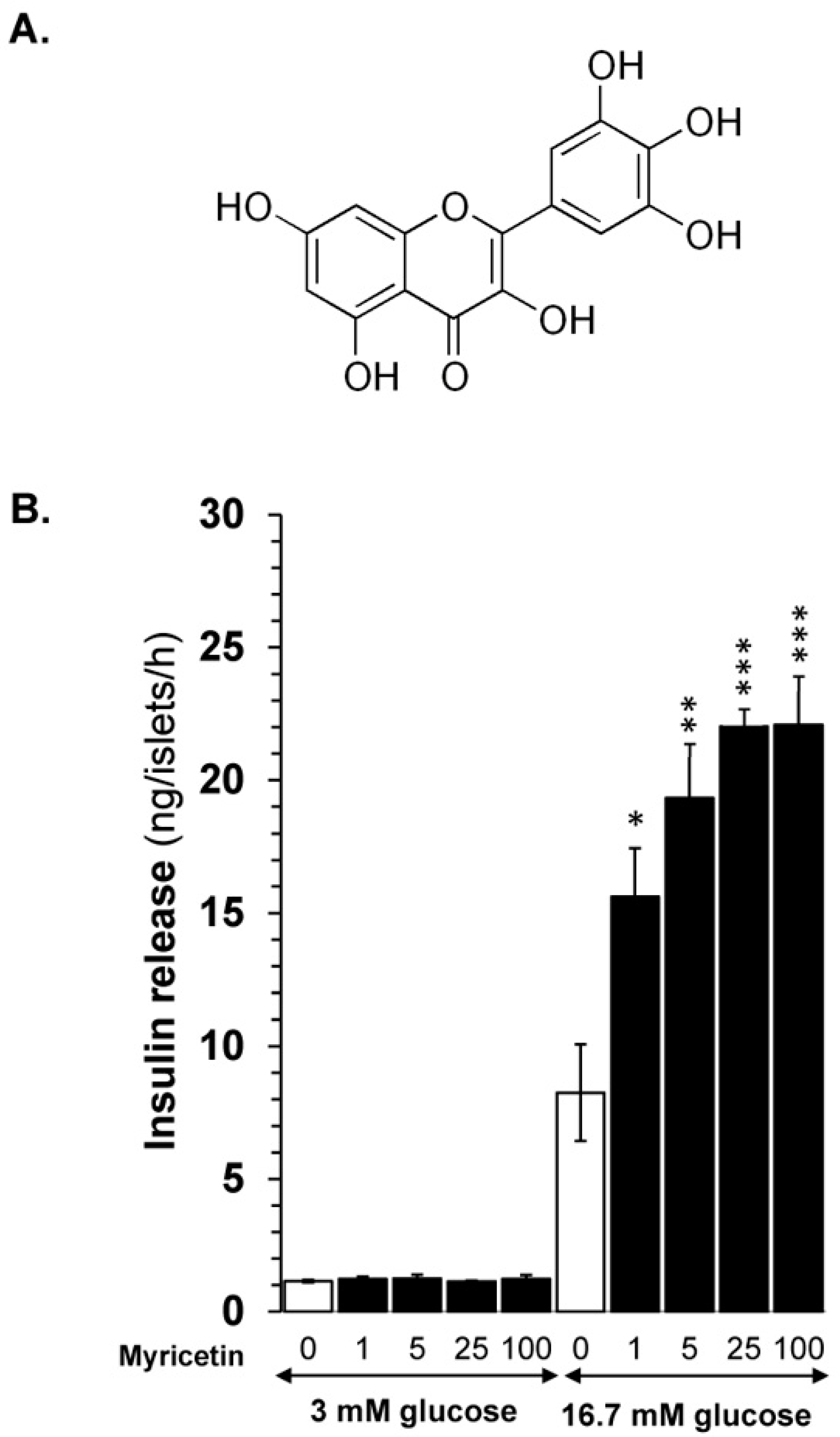
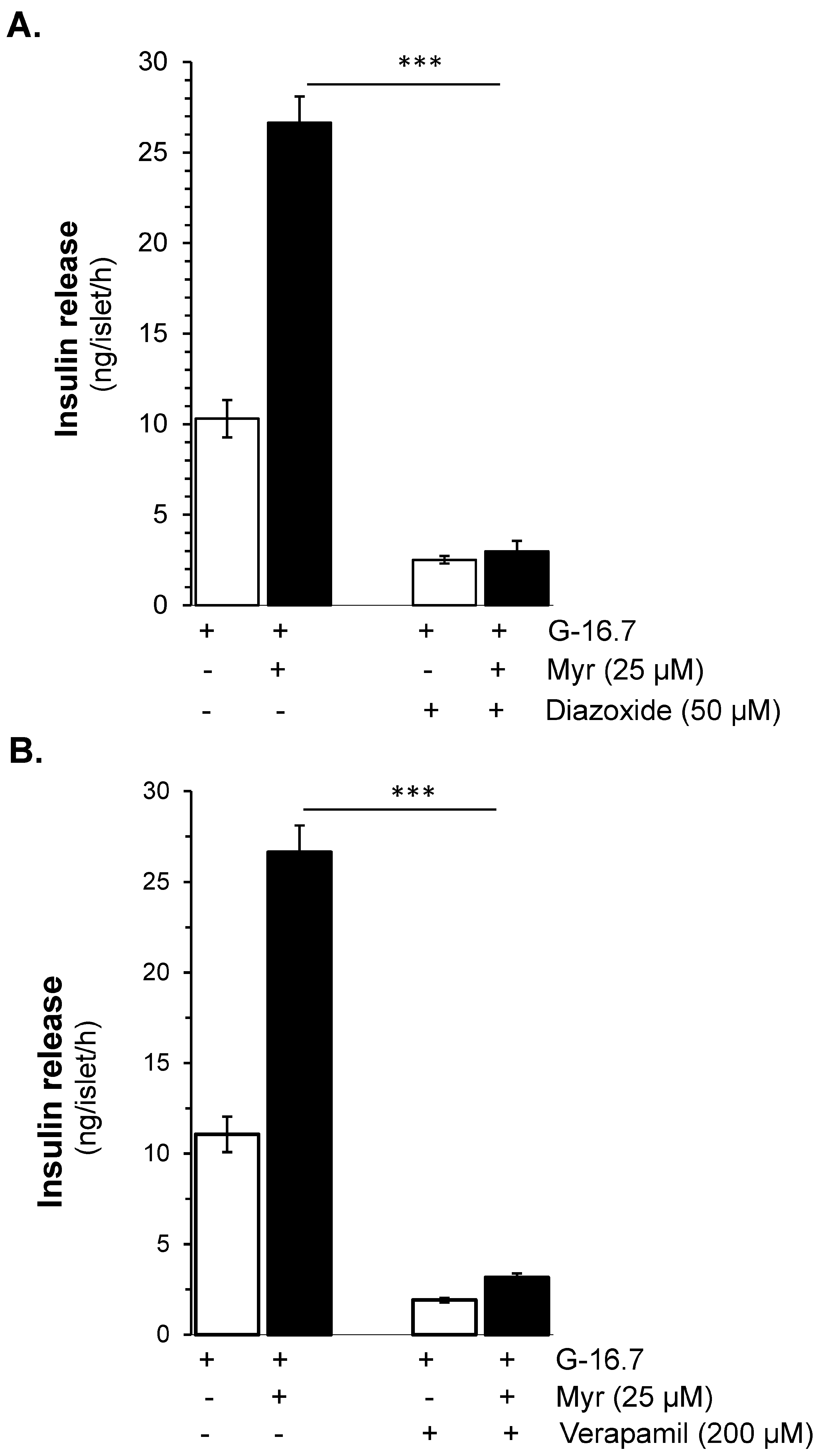

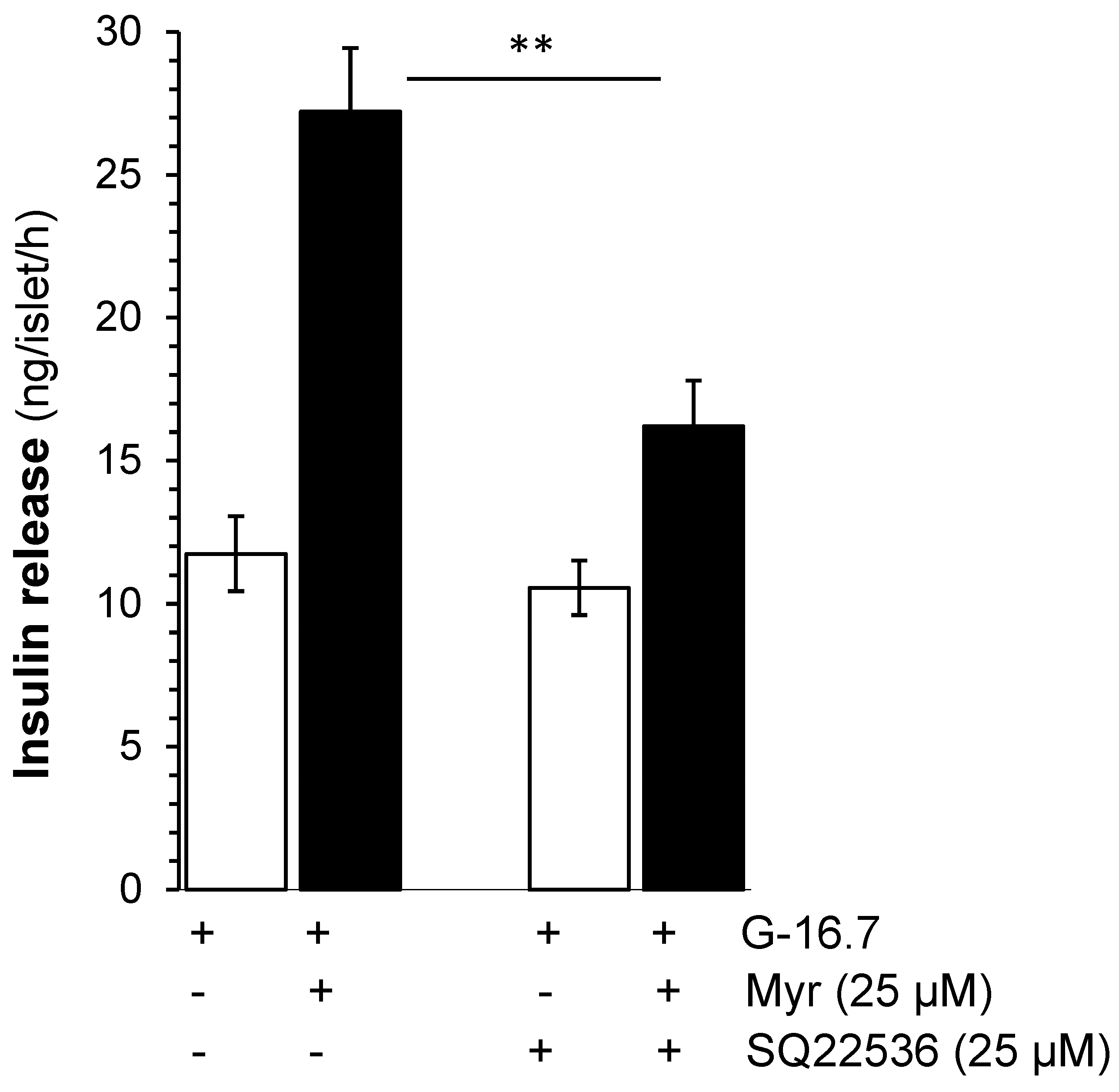
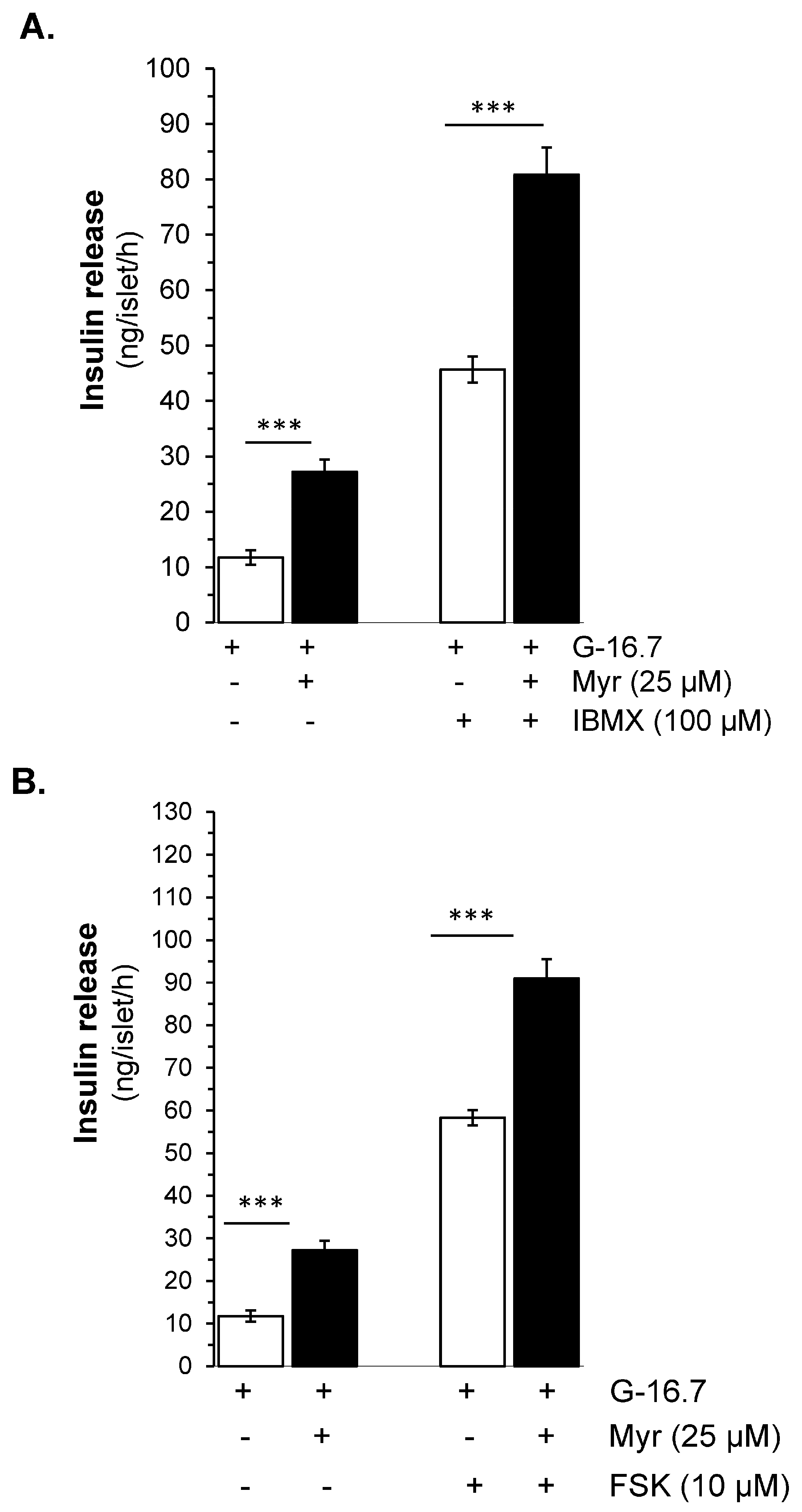
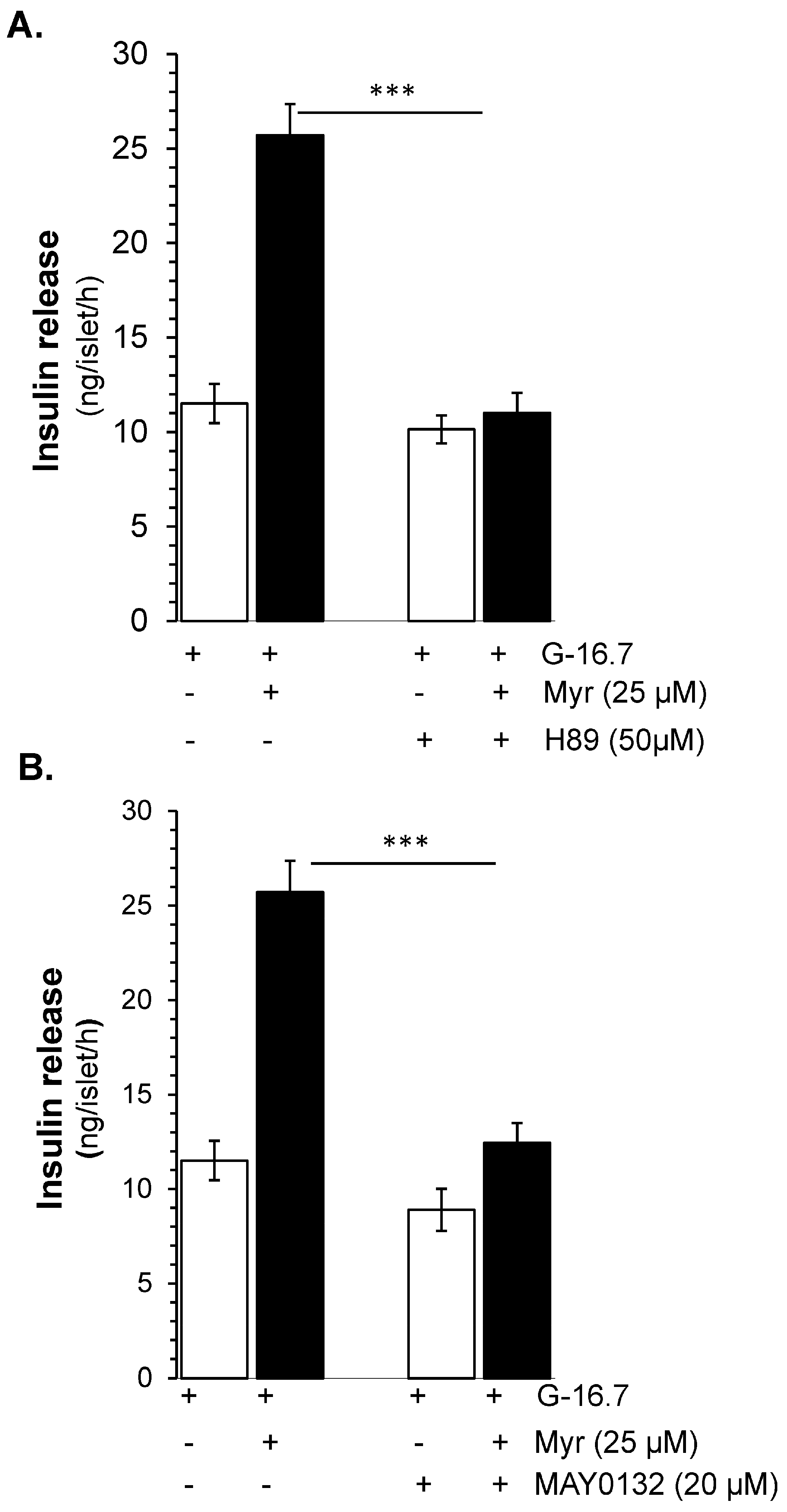
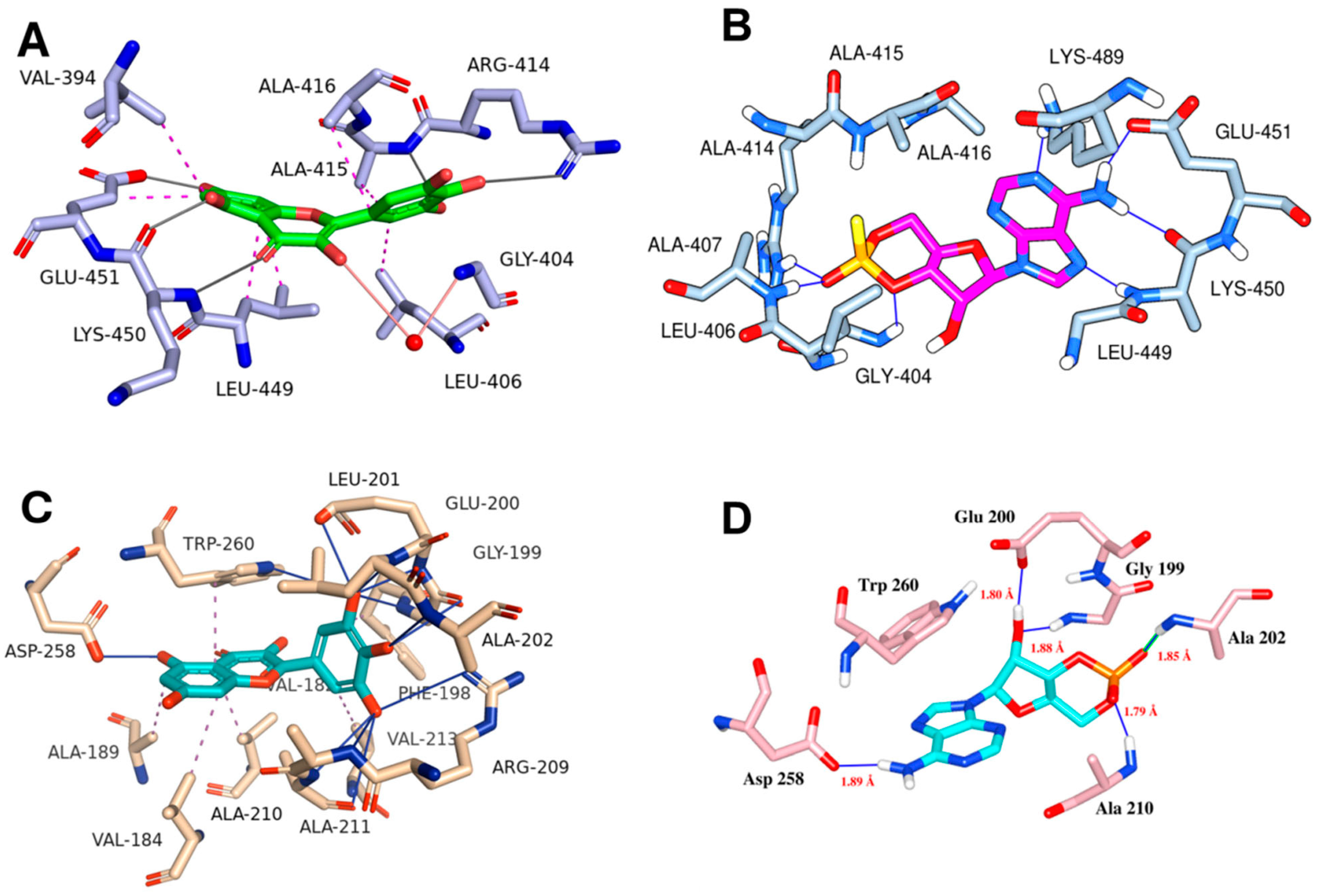
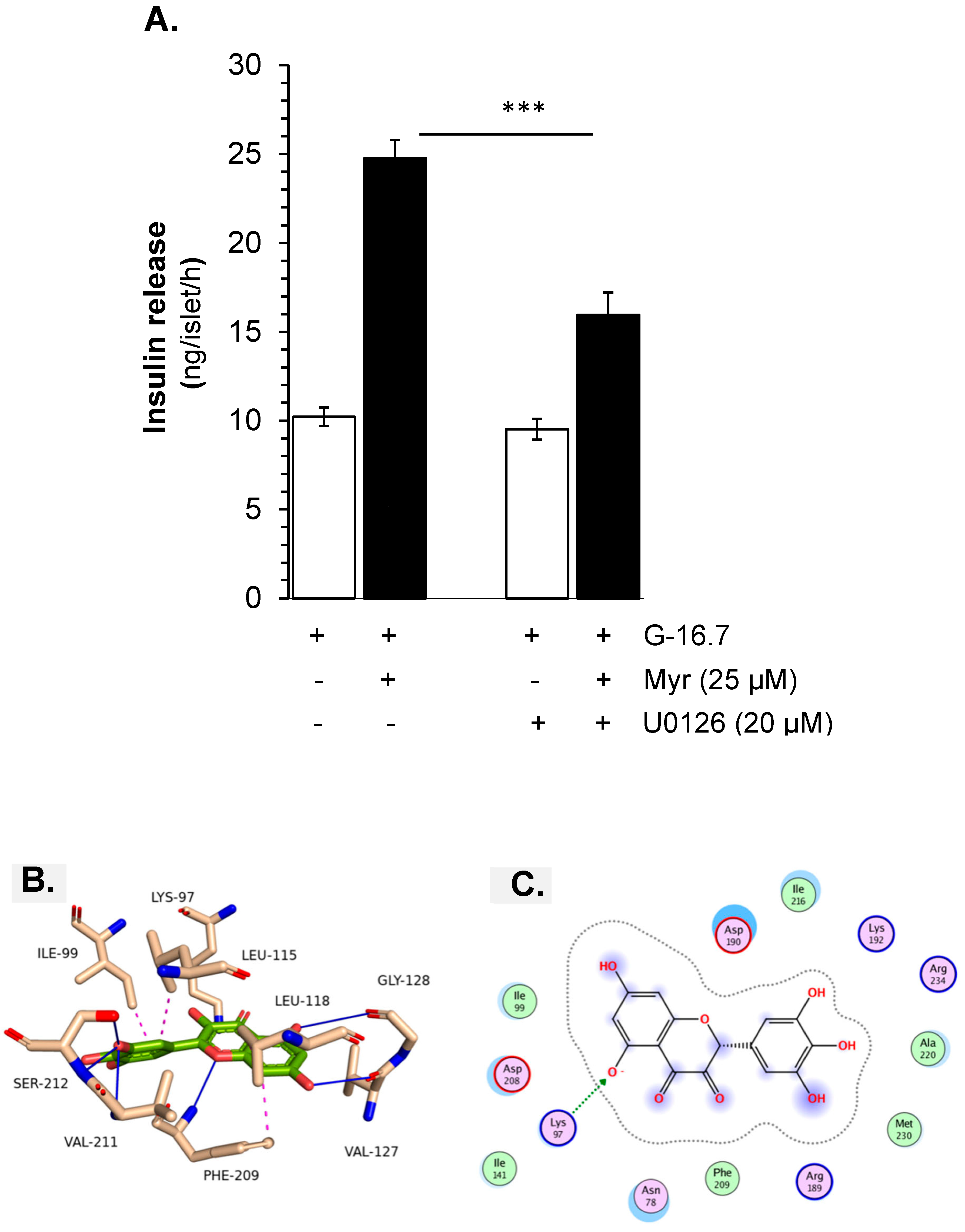
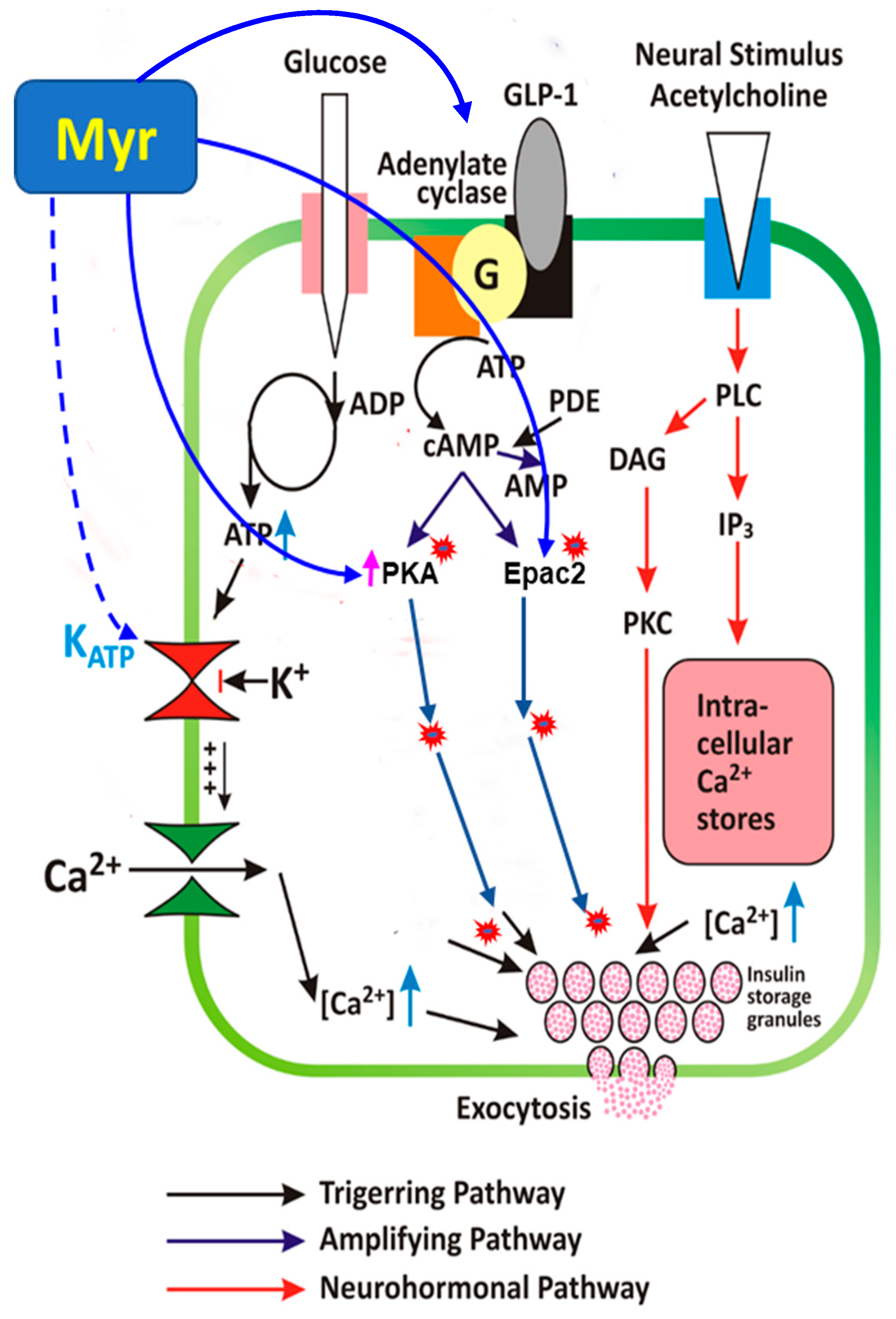
| Target | Type of Interaction, Residue (Distance) |
|---|---|
| Epac-2 | Hydrophobic: VAL-394E (3.96), LEU-406E (3.79), ALA-415E (3.97), ALA-416E (3.80), LEU-449E (3.75), LEU-449E (3.87), GLU-451E (3.58) |
| Hydrogen Bond: ARG-414E (2.08), ALA-415E (2.15), LYS-450E (1.55), LYS-450E (2.03), GLU-451E (1.59) | |
| Water Bridge: GLY-404E (4.04) | |
| Hydrogen Bond: THR-401C (2.13), VAL-420C (2.20), ASP-481C (2.52) | |
| MEK Kinase | Hydrophobic: ILE-99A (3.46), LEU-115A (3.54), LEU-118A (3.45), PHE-209A (3.38) |
| Hydrogen Bond: LYS-97A (3.02), VAL-127A (2.47), GLY-128A (3.18), PHE-209A (2.38), VAL-211A (2.55), SER-212A (2.83), SER-212A (2.98) | |
| PKA RIα, Homodimer | Hydrogen Bond: GLY-199A (1.85), GLU-200A (2.66), GLU-200A (2.95), LEU-201A (2.77), ALA-202A (1.74), ALA-210A (1.91), ASP-258A (2.77), TRP-260A (2.50) |
| π-Stacking: TRP-260A (4.42), TRP-260A (3.45), TRP-260A (3.90) | |
| Salt Bridge: ARG-209A (4.59) |
Disclaimer/Publisher’s Note: The statements, opinions and data contained in all publications are solely those of the individual author(s) and contributor(s) and not of MDPI and/or the editor(s). MDPI and/or the editor(s) disclaim responsibility for any injury to people or property resulting from any ideas, methods, instructions or products referred to in the content. |
© 2025 by the authors. Licensee MDPI, Basel, Switzerland. This article is an open access article distributed under the terms and conditions of the Creative Commons Attribution (CC BY) license (https://creativecommons.org/licenses/by/4.0/).
Share and Cite
Ali, A.; Memon, Z.; Hameed, A.; Ul-Haq, Z.; Ali, M.; Hafizur, R.M. Myricetin Amplifies Glucose–Stimulated Insulin Secretion via the cAMP-PKA-Epac-2 Signaling Cascade. Biomedicines 2025, 13, 1447. https://doi.org/10.3390/biomedicines13061447
Ali A, Memon Z, Hameed A, Ul-Haq Z, Ali M, Hafizur RM. Myricetin Amplifies Glucose–Stimulated Insulin Secretion via the cAMP-PKA-Epac-2 Signaling Cascade. Biomedicines. 2025; 13(6):1447. https://doi.org/10.3390/biomedicines13061447
Chicago/Turabian StyleAli, Akhtar, Zahida Memon, Abdul Hameed, Zaheer Ul-Haq, Muneeb Ali, and Rahman M. Hafizur. 2025. "Myricetin Amplifies Glucose–Stimulated Insulin Secretion via the cAMP-PKA-Epac-2 Signaling Cascade" Biomedicines 13, no. 6: 1447. https://doi.org/10.3390/biomedicines13061447
APA StyleAli, A., Memon, Z., Hameed, A., Ul-Haq, Z., Ali, M., & Hafizur, R. M. (2025). Myricetin Amplifies Glucose–Stimulated Insulin Secretion via the cAMP-PKA-Epac-2 Signaling Cascade. Biomedicines, 13(6), 1447. https://doi.org/10.3390/biomedicines13061447






